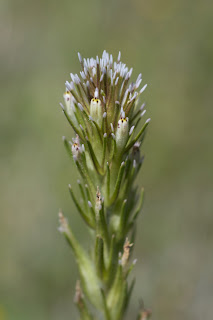 |
| Camassia scilloides |
Back in April of this year Brian and I spent a week in the Eureka Springs area of northwestern Arkansas. We're planning a relocation there the first half of next year some time. This is prime
Ozarks territory and the countryside is verdant, lush and green.
I picked up a hiking book at the local megabookstore during our day trip to Fayetteville and thumbed through it for a day or so. There were a couple hikes that were close to Eureka Springs: Lake Leatherwood and Shaddox Hollow Loop in the Hobbs State Park / Conservation Management Area. I've
already blogged about Lake Leatherwood.
 |
| Camassia scilloides |
The drive from Eureka Springs over to Shaddox Hollow took me through rolling green hills dotted with houses, farms, and the occasional light industry. I see a flash of pale blue go by to my right, on the north side of the road. A few u-turns later on the sleepy road I find a safe place to pull over. I get out of the car and walk back a dozen yards or so to find a spectacular mass bloom of
Camassia scilloides. This is only the second species of
Camassia I've seen, but I really love them. The pale blue heads of flowers evoke blue fireworks going off over the grass. An added bonus - the hillside is in the shadow of the morning sun and dew droplets are everywhere.
 |
| Trillium viridescens |
I was very pleasantly surprised to find a robust and healthy colony of
Trillium viridescens in the ditch itself! They were a little wind and insect damaged but were otherwise in great shape, with almost all plants in bloom.
Once I enter Hobbs State Park, the farms and houses disappear and the forest comes almost up to the side of the road. Along the shoulder were miles of
Viola pedata, one of the showiest
Viola I've ever seen! Upon reaching Shaddox Hollow I check in on the clipboard at the trailhead and head out. I didn't stay long - the entire area had undergone a controlled burn 4 weeks earlier. Burns of this nature are an integral part of maintaining a healthy forest but you have to visit them the next season, not 4 weeks, to see what a positive effect they have. After about 20 minutes and realizing the burn covered the entire area I headed back to the car.
 |
| Viola pedata |
 |
| Arisaema atrorubens |
On the drive in, I'd noticed a few other trailheads so I stopped at one of them on the way back: Van Winkle Hollow. The main attraction here is a restored lumber mill and attendant examples of life in the area during the mid-19th century. More interesting to me was a short wildflower trail right off the parking area. The trail was a short loop around the creek in the hollow. I noticed a controlled burn had happened here, too, but stopped short about 15 yards from the water's edge. A full crop of wildflowers was in bloom!
I was greeted by a bright yellow clump of
Senecio aureus along the water's edge at the start of the trail. Drifts of
Polemonium reptans and
Collinsia verna were along both sides of the trail. Then I spot
Arisaema atrorubens. It was stunning! A surprisingly large flower, almost 2 feet tall, it really lives up to the Jack-in-the-Pulpit common name. This was quickly followed by another spectacular find, the miniature crested iris,
Iris cristata.
 |
| Collinsia verna |
As I continued down the trail, there were
Vitis vines here and there, surprisingly little Japanese honeysuckle, but it
was present. The American Dogwood,
Cornus florida, were almost finished blooming but every so often one would be in perfect condition. I started seeing large patches of
Podophyllum peltatum along with
Phlox divaricata.
 |
| Iris cristata |
Taking a detour up to the edge of the floodplain and up the gently sloping hillside i find a huge colony of
Adiantum pedatum. The newly emerging fronds were captivating. Other species I noticed were
Ribes missouriense,
Viola pubescens,
Hydrophyllum virginianum, and lots of
Delphinium. One of the last things on the trail was a large
Platanus occidentalis with a hole in the base of the trunk. The tree was leaning a bit but otherwise seemed perfectly fine. Nature!
Here are some additional shots from the day:
 |
| Adiantum pedatum |
 |
| Polemonium reptans |
 |
| Podophyllum peltatum |
 |
| Ribes missouriense |
 |
| Cornus florida |




















































